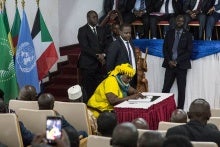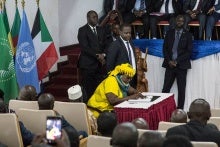New York, 22 October – The effects of war and conflict on women and girls are worsening. In 2023, the proportion of women killed in armed conflicts doubled compared to 2022. Four out of every ten people who died as a result of conflict in 2023 were women. UN-verified cases of conflict-related sexual violence increased by 50 per cent.
[Also available in Arabic]
These increases in deaths during war and in violence against women are taking place against a backdrop of increasing blatant disregard of international law designed to protect women and children during war. For example, women in war zones are also increasingly suffering from restricted access to healthcare. Every day, 500 women and girls in conflict-affected countries die from complications related to pregnancy and childbirth. By the end of 2023, 180 women were giving birth every day in war-torn Gaza—most without necessities or medical care.
This is the dire picture painted by the latest annual report by UN Secretary-General António Guterres on Women, Peace, and Security, led by UN Women. The report comes 24 years after the adoption of Security Council resolution 1325, which called for all parties to conflicts to ensure the safety of women and girls, and for women’s full involvement in peace processes.
“Women continue to pay the price of the wars of men,” said UN Women Executive Director, Sima Bahous. “This is happening in the context of a larger war on women. The deliberate targeting of women’s rights is not unique to conflict-affected countries but is even more lethal in those settings. We are witnessing the weaponization of gender equality on many fronts, if we do not stand up and demand change, the consequences will be felt for decades, and peace will remain elusive” she added.
Despite commitments to ensure women’s full and meaningful participation in peace and security matters made over many years, political and military power and decision-making around conflicts continue to be overwhelmingly dominated by men. Women made up only 9.6 per cent of negotiators in peace processes in 2023, even though studies show that when women are involved, peace agreements last longer and are better implemented.
In Yemen, for example, women-led negotiations resulted in safe access to a water source for civilians. In Sudan, 49 women-led organizations are pushing for a more inclusive peace process. These efforts are largely unsupported or unrecognized in formal peace negotiations.
One of the key challenges in realizing women, peace and security commitments identified in the report is the severe lack of funding. In 2023, global military expenditures reached a record $2.44 trillion. In contrast, funding for organizations and movements supporting women’s rights continues to fall short, averaging just 0.3 per cent of total aid annually—especially in conflict-affected areas. Investments in gender-based violence prevention and response make up less than one per cent of all humanitarian spending.
In 2025, the world will reach a series of anniversaries of significant global actions that were intended to promote gender equality and human rights for everybody, most notably the 30th commemoration of the Beijing Platform for Action, the most visionary blueprint on women’s rights ever adopted by 189 countries. The report concludes that only through bold political action and increased funding, will women’s equal and meaningful participation in peace and security become a reality: a reality that is essential for achieving lasting peace for all.

